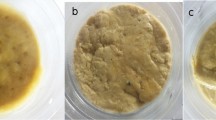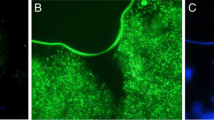Abstract
This investigation reports the effect of microencapsulation using sodium alginate and starch on the tolerance of probiotic Lactobacillus acidophilus LA1 to selected processing conditions and simulated gastrointestinal environments. The organism survived better in the protected form at high temperatures (72, 85, and 90 °C) and at high salt concentrations (1%, 1.5%, and 2%). The free cells were completely destroyed at 90 °C whereas the microencapsulated cells reduced by 4.14 log cycles. The log cycle reduction was 5.67 and 2.30, respectively, in free and protected cells when incubated for 3 h with 2% (w/v) NaCl. Homogenization did not affect the viability of the cells but led to the disruption of the protective encapsulating material around the cells. Microencapsulation provided better protection at simulated conditions of gastric pH (1.0, 1.5, and 2.0) and at high bile salt concentrations (1.0%, 1.5%, and 2.0%). The free and protected cells registered 5.47 and 2.16 log cycle reduction, respectively, after 3-h incubation at 2% bile salt (w/v). The release of the microencapsulated organisms in simulated colonic pH required 2.5 h. These studies demonstrated that microencapsulation of probiotic L. acidophilus LA1 in sodium alginate is an effective technique of protection against extreme processing conditions and under simulated gastrointestinal environment.





Similar content being viewed by others
References
Ang, D., Lieereck, K., Skowyra, D., Zylicz, M., & Georgopoulos, C. (1991). Biological role and regulation of the universally conserved heat shock proteins. Journal of Biological Chemistry, 266(36), 24233–24236.
Berrada, N., Lemeland, J. F., Laroche, G., Thovenot, P., & Piaia, M. (1991). Bifidobacterium from fermented milks: Survival during gastric transit. Journal of Dairy Science, 74(2), 409–413.
Chandramouli, V., Kailasapathy, K., Peiris, P., & Jones, M. (2004). An improved method of microencapsulation and its evaluation to protect Lactobacillus spp in simulated gastric conditions. Journal of Microbiological Methods, 56(1), 27–35. doi:10.1016/j.mimet.2003.09.002.
Clark, P. A., & Martin, J. H. (1994). Selection of Bifidobacteria for use as dietary adjuncts in cultured dairy foods: III-Tolerance to simulated bile concentrations of human small intestines. Cultured Dairy Products Journal, 29(3), 20–21, 18.
Conway, P. L., Gorbach, S. L., & Goldin, B. R. (1987). Survival of lactic acid bacteria in the human stomach and adhesion to intestinal cells. Journal of Dairy Science, 70(1), 1–12.
Ding, W. K., & Shah, N. P. (2007). Acid, bile, and heat tolerance of free and microencapsulated probiotic bacteria. Journal of Food Science, 72(9), 446–450, (1).
FAO/WHO, (2001). Health and nutritional properties of probiotics in food including powder milk with live lactic acid bacteria. Report of a Joint FAO/WHO Expert Consultation on Evaluation of Health and Nutritional Properties of Probiotics in Food Including Powder Milk with Live Lactic Acid Bacteria. Córdoba, Argentina. 1–4 October. ftp://ftp.fao.org. Accessed 1 March 2007.
Fernandez-Salguero, J., Alcala, M., Marcos, A., & Esteban, M. A. (1986). Measurement and calculation of water activity in blue cheese. Journal of Dairy Research, 53(4), 639–644.
Gardiner, G. E., O’Sullivan, E., Kelly, J., Auty, M. A. E., Fitzgerald, G. F., Collins, J. K., et al. (2000). Comparative survival rates of human-derived probiotic Lactobacillus paracasei and L. salivarius strains during heat treatment and spray drying. Applied and Environmental Microbiology, 66(6), 2605–2612. doi:10.1128/AEM.66.6.2605-2612.2000.
Gomes, A. M. P., Teixeira, M. G. M., & Malcata, F. X. (1998). Viability of Bifidobacterium lactis and Lactobacillus acidophilus in milk: Sodium chloride concentration and storage temperature. Journal of Food Processing and Preservation, 22(3), 221–240. doi:10.1111/j.1745-4549.1998.tb00347.x.
Gouin, S. (2004). Microencapsulation: Industrial appraisal of existing technologies and trends. Trends in Food Science & Technology, 15(7–8), 330–347. doi:10.1016/j.tifs.2003.10.005.
Guerin, D., Vuillemard, J. C., & Subirade, M. (2003). Protection of bifidobacteria encapsulated in polysaccharide–protein gel against gastric juice and bile. Journal of Food Protection, 66(11), 2067–2084.
Guinee, T. P., & Fox, P. F. (1993). Salt in cheese: Physical, chemical and biological aspects. In P. F. Fox (Ed.), Cheese: Chemistry, physics and microbiology (vol. 1, (pp. 257–302)). London: Elsevier.
Hannoun, B., & Stephanopoulos, G. (1986). Diffusion coefficient of glucose and ethanol in cell-free and cell-occupied calcium alginate membranes. Biotechnology and Bioengineering, 28(6), 829–835. doi:10.1002/bit.260280609.
Houghtby, G. A., Maturin, L. J., & Koenig, E. K. (1993). Microbiological count methods. In Marshall (Ed.), Standard methods for the examination of dairy products (pp. 213–246, 16th ed.). Washington DC, USA: American Public Health Association.
Jeffery, R. B., Oberg, J. C., Wang, H., & Wie, L. (1997). Attributes of the heat shock response in three species of dairy Lactobacillus. Systematic and Applied Microbiology, 20(1), 12–19.
Jorgensen, F., Nybroe, O., & Knochel, S. (1994). Effects of starvation and osmotic stress on viability and heat resistance of Pseudomonas fluorescens AH9. Journal of Applied Bacteriology, 77(3), 340–347.
Kailasapathy, K. (2002). Microencapsulation of probiotic bacteria: Technology and potential applications. Current Issues in Intestinal Microbiology, 3, 39–48.
Kailasapathy, K., & Chin, J. (2000). Survival and therapeutic potential of probiotic organisms with reference to Lactobacillus acidophilus and Bifidobacterium spp. Immunology and Cell Biology, 78(1), 80–88. doi:10.1046/j.1440-1711.2000.00886.x.
Kailasapathy, K., & Sureeta, B. S. (2004). Effect of storage on shelf life and viability of freeze dried and microencapsulated Lactobacillus acidophilus and Bifidobacterium infantis cultures. Australian Journal of Dairy Technology, 59(3), 204–208.
Kim, W. S., Perl, L., Park, H. J., Tandianus, E. J., & Dunn, W. N. (2001). Assessment of stress response of the probiotic Lactobacillus acidophilus. Current Microbiology, 43(5), 346–350. doi:10.1007/s002840010314.
Kneifel, W., Jaros, D., & Erhard, F. (1993). Microflora and acidification properties of yoghurt and yoghurt-related products fermented with commercially available starter cultures. International Journal of Food Microbiology, 18(3), 179–189. doi:10.1016/0168-1605(93)90043-G.
Krasaekoopt, W., Bhandari, B., & Deeth, H. (2003). Evaluation of encapsulation techniques of probiotics for yoghurt. International Dairy Journal, 13(1), 3–13. doi:10.1016/S0958-6946(02)00155-3.
Krasaekoopt, W., Bhandari, B., & Deeth, H. (2004). The influence of coating materials on some properties of alginate beads and survivability of microencapsulated probiotic bacteria. International Dairy Journal, 14(8), 737–743. doi:10.1016/j.idairyj.2004.01.004.
Lee, K. Y., & Heo, T. R. (2000). Survival of Bifidobacterium longum immobilized in calcium alginate beads in simulated gastric juices and bile salt solution. Applied and Environmental Microbiology, 66(2), 869–873. doi:10.1128/AEM.66.2.869-873.2000.
Lee, J. S., Cha, D. S., & Park, H. J. (2004). Survival of freeze-dried Lactobacillus bulgaricus KFRI 3673 in chitosan-coated calcium alginate microparticles. Journal of Agricultural and Food Chemistry, 52(24), 7300–7305. doi:10.1021/jf040235k.
Lourens-Hattingh, A., & Viljoen, B. C. (2001). Yoghurt as probiotic carrier food. International Dairy Journal, 11(1–2), 1–17. doi:10.1016/S0958-6946(01)00036-X.
Mandal, S., Puniya, A. K., & Singh, K. (2006). Effect of alginate concentrations on survival of microencapsulated Lactobacillus casei NCDC-298. International Dairy Journal, 16(10), 1190–1195. doi:10.1016/j.idairyj.2005.10.005.
Markussen, E. K., & Falholt, P. (1989). Granulate detergent enzyme product, method for production thereof, use thereof, and detergent containing such product. International Patent No WO 89/08694 (In English).
Mosilhey, S. H. (2003). Influence of different capsule materials on the physiological properties of microencapsulated Lactobacillus acidophilus. Dissertation thesis in Agricultural Sciences. Submitted to the University of Bonn. Universitäts-und Landesbibliothek Bonn. Available at: http://hss.ulb.uni-bonn.de. Accessed 27 April 2007.
Picot, A., & Lacroix, C. (2004). Encapsulation of bifidobacteria in whey protein-based microcapsules and survival in simulated gastrointestinal conditions and in yoghurt. International Dairy Journal, 14(6), 505–515. doi:10.1016/j.idairyj.2003.10.008.
Redenbaugh, M. K., & Reyes, Z. (1985). Coating hydrogel capsules. International Patent No WO 85/002972 (In English).
Rao, A. V., Shiwnarain, N., & Maharaj, I. (1989). Survival of microencapsulated Bifidobacterium pseudolongum in simulated gastric and intestinal juices. Canadian Institute of Food Science and Technology, 22(4), 345–349.
Roy, D. (1991). Salt stress on growth and acid production of Lactobacillus helveticus strain Milano. Letters in Applied Microbiology, 12(6), 207–211. doi:10.1111/j.1472-765X.1991.tb00541.x.
Shah, N. P., & Ravula, R. R. (2000). Microencapsulation of probiotic bacteria and their survival in frozen fermented dairy desserts. Australian Journal of Dairy Technology, 55(3), 139–144.
Sheu, T. Y., & Marshall, R. T. (1993). Microencapsulation of lactobacilli in calcium alginate gels. Journal of Food Science, 54(3), 557–561. doi:10.1111/j.1365-2621.1993.tb04323.x.
Sheu, T. Y., Marshall, R. T., & Heymann, H. (1993). Improving survival of culture bacteria in frozen desserts by microentrapment. Journal of Dairy Science, 79(7), 1902–1907.
Silva, J., Carvahlo, A. S., Teixeira, P., & Gibbs, P. A. (2002). Bacteriocin production by spray dried lactic acid bacteria. Letters in Applied Microbiology, 34(2), 77–81. doi:10.1046/j.1472-765x.2002.01055.x.
Sultana, K., Godward, G., Reynolds, N., Arumugaswamy, R., Peiris, P., & Kailasapathy, K. (2000). Encapsulation of probiotic bacteria with alginate-starch and evaluation of survival in simulated gastrointestinal conditions and in yoghurt. International Journal of Food Microbiology, 62(1–2), 47–55. doi:10.1016/S0168-1605(00)00380-9.
Sun, W., & Griffiths, M. W. (2000). Survival of bifidobacteria in yoghurt and simulated gastric juice following immobilization in gellan–xanthan beads. International Journal of Food Microbiology, 61(1), 17–25. doi:10.1016/S0168-1605(00)00327-5.
Tetra Pak Process Syst (2003). Dairy processing handbook (II ed.). Lund: Tetra Pak Process Syst.
Trindade, F. S. F., & Grosso, C. R. F. (2000). The effect of the immobilization of Lactobacillus acidophilus and Bifidobacterium lactis in alginate on their tolerance to gastrointestinal secretions. Milchwissenschaft, 55(9), 496–499.
Wang, X., Brown, I. L., Evans, A. J., & Conway, P. L. (1999). The protective effects of high amylose maize (amylomaize) starch granules on the survival of Bifidobacterium spp. in the mouse intestinal tract. Journal of Applied Microbiology, 87(5), 631–639. doi:10.1046/j.1365-2672.1999.00836.x.
Author information
Authors and Affiliations
Corresponding author
Rights and permissions
About this article
Cite this article
Sabikhi, L., Babu, R., Thompkinson, D.K. et al. Resistance of Microencapsulated Lactobacillus acidophilus LA1 to Processing Treatments and Simulated Gut Conditions. Food Bioprocess Technol 3, 586–593 (2010). https://doi.org/10.1007/s11947-008-0135-1
Received:
Accepted:
Published:
Issue Date:
DOI: https://doi.org/10.1007/s11947-008-0135-1




